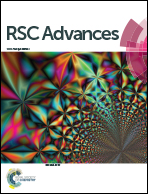Copper/β-diketone-catalysed N-arylation of carbazoles†
Abstract
A copper-catalysed C–N bond-forming reaction of carbazoles with aryl iodides is described. Several commercially available ligands such as β-diketone and diamine, are tested in the N-arylation of carbazoles. The catalytic system generated in situ from an inexpensive copper salt, simple β-diketone and inorganic base efficiently N-arylated the carbazoles. A wide range of aryl iodides and carbazoles can be coupled to generate N-arylcarbazoles in the presence of various functional groups. However, the sterically hindered effect of aryl iodides is evident in this catalytic system. The selectivity of two iodine atoms on the aromatic ring of diiodobenzene is evaluated in the developed catalytic system. Results showed that the selectivity of diiodobenzene can be tuned by the reaction temperature.


 Please wait while we load your content...
Please wait while we load your content...